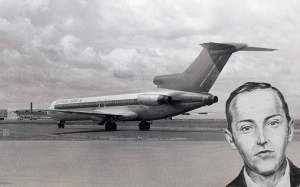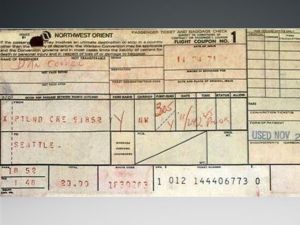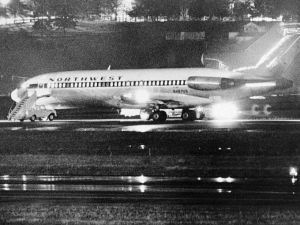




To mark the 49th anniversay of the most audacious and (possibly) only successful skyjacking in U.S. aviation history on Nov. 24, 1971, BBC Four has broadcast the new Storyville documentary The Hijacker Who Vanished: The Mystery of DB Cooper by John Dower, the director of My Scientology Movie, who picked through the evidence, considering possible endings as well as telling the stories of those who may have been, or claimed to be, D.B. Cooper. Since 1997, BBC’s Storyville has been working with filmmakers to bring “the globe’s best feature documentary stories to festival, cinema and television audiences,” BBC says.
“Fans of modern American folklore may be familiar with the story … but even those who are not should relish this authoritative opportunity to pull up a seat and get out the popcorn, writes Rebecca Nicholson in The Guardian.
I came kind of late to writing about the D.B. Cooper case, first penning a column on it nine years ago for the Thompson Citizen back on Nov. 23, 2011. I wrote:
“Who was D.B. Cooper?
“The question still preoccupies old-time FBI agents and mystery aficionados alike for it was 40 years ago tomorrow – Nov. 24, 1971 – a Wednesday and the day before American Thanksgiving, just as today is, that someone using the alias Dan Cooper committed the most audacious act of air piracy in U.S. history with the mid-afternoon skyjacking of Northwest Orient Airlines Flight 305, flying over the Pacific Northwest, en route from Portland, Oregon to Seattle, Washington” with 36 passengers and six crew members aboard.
The man now known by the alias D.B. Cooper paid $20 cash, which included tax, for his airline ticket in Portland. Once on board, Cooper, a nondescript man possibly with a slight Midwestern accent, ordered a bourbon-and-soda, before passing a note to flight attendant Florence Schaffner demanding $200,000 ransom in unmarked $20 bills and two back parachutes and two front parachutes. ‘I HAVE A BOMB IN MY BRIEFCASE. I WILL USE IT IF NECESSARY. I WANT YOU TO SIT NEXT TO ME. YOU ARE BING (sic) HIJACKED.’ Initially, Schaffner dropped the note unopened into her purse, until Cooper leaned toward her and whispered, “Miss, you’d better look at that note. I have a bomb.” Cooper smoked eight Raleigh filter-tipped cigarettes on the plane, but there was no evidence to show if this was a regular habit of his.
The skyjacked flight landed at Tacoma International Airport in Seattle, where passengers were exchanged for parachutes, including possibly an NB-8 rig with a C-9 canopy, known as a “double-shot” pinch-and-pull system that in 1971 would have allowed jumpers to disengage quickly from their chutes after they landed so that the wind did not drag them, and the cash, all in $20 bills, as he had demanded, although not unmarked it would turn out. The passengers were never aware of the threat onboard. A bank in Seattle was contacted and a bag of money, all $20 bills with recorded serial numbers, totalling $200,000, was delivered to the plane, which was refuelled and cleared for take off. The bag of ransom money itself weighed 23 pounds.
The plane took off again, heading toward Mexico at the hijacker’s command, with only Cooper and the crew aboard about half an hour later. Cooper told the pilot to fly a low-speed, low-altitude flight path at about 120 mph, close to the minimum before the plane would go into a stall, at a maximum 10,000 feet, to aid in his jump. To ensure a minimum speed he specified that the landing gear remain down, in the take off and landing position, and the wing flaps be lowered 15 degrees. To ensure a low altitude he ordered that the cabin remain unpressurized.
He bailed out into the rainy night through the plane’s rear stairway, which he lowered himself, somewhere near the Washington-Oregon boundary in Washington State, probably near Ariel in Cowlitz County, or possibly around Washougal or Camas in Clark County.
Along with FBI, Washington and Oregon state police, and local law enforcement officials, about 1,000 army troops and helicopters were also used in the 1971 search for Cooper.
In 1978, a placard containing instructions for lowering the aft stairs of a 727 was found by a deer hunter east of Castle Rock in Cowlitz County, which was within the basic flight path of the plane Cooper jumped from, according to the FBI and news reports.
In February 1980, eight-year-old Brian Ingram, vacationing with his family on the Columbia River about 20 miles southwest of Ariel, uncovered three packets of $5,800 of the ransom cash, disintegrated but still bundled in rubber bands, as he raked the sandy riverbank beachfront at an area known as Tena Bar to build a campfire on the Columbia River about 20 miles southwest of Ariel.
In the first five years after the skyjacking, the FBI considered over 800 suspects, KVAL CBS 13 in Eugene Oregon reported last week. And the suspect list since 2011, both living and dead, when I first wrote about it, has grown from nine frequently discussed suspects over the years: Kenneth Christiansen, Lynn Doyle Cooper, Richard Floyd McCoy, Jr., Duane Weber, Jack Coffelt, William Gossett, Barbara (formerly Bobby) Dayton, John List and Ted Mayfield, most of whom had military combat experience, to now also include most recently William J. Smith, Robert W. Rackstraw and Dick Lepsy, and as an outside long shot, James (Jim) Hugh Macdonald, 46, the owner of J.H. Macdonald & Associates Ltd., consulting structural engineers on Pembina Highway in Winnipeg, who climbed into his Mooney Mark M20D single-engine prop aircraft, bearing the registration mark CF-ABT, and took off half an hour after sunset from the Thompson Airport in Northern Manitoba at 4:30 p.m. on Dec. 7, 1971 – a couple of weeks after the D.B. Cooper skyjacking – to make his return flight home to Winnipeg and disappeared into the rapidly darkening sky to never be seen or heard from again. He was the sole occupant of the four-seater plane.
John List, a Second World War and Korean War veteran exited his ho-hum existence as a failed New Jersey accountant by killing his family in 1971, murdering his wife, three teenage children, and 85-year-old mother in New Jersey 15 days before the Cooper hijacking. After the murders, List withdrew $200,000 from his mother’s bank account and disappeared. He wasn’t arrested until 18 years later after Fox-TV’s America’s Most Wanted featured the case in a May 21, 1989 segment, displaying a bust of what an older John List might look like. The network estimated that 22 million people saw it. One was a woman in a suburb of Richmond, Virginia, who thought the bust looked like a neighbour, Robert Clark, a churchgoing accountant who wore horn-rimmed glasses. List, alias Clark, was arrested, tried and convicted, dying in custody in March 2008 at the age of 82.
“Following one of the longest and most exhaustive investigations in our history,” said Ayn Dietrich-Williams, a public affairs specialist with the FBI Seattle Field Office, “on July 8, 2016, the FBI redirected resources allocated to the D.B. Cooper case in order to focus on other investigative priorities. During the course of the 45-year NORJAK investigation, the FBI exhaustively reviewed all credible leads, co-ordinated between multiple field offices to conduct searches, collected all available evidence, and interviewed all identified witnesses. Over the years, the FBI has applied numerous new and innovative investigative techniques, as well as examined countless items at the FBI Laboratory. Evidence obtained during the course of the investigation will now be preserved for historical purposes at FBI Headquarters in Washington, D.C.”
Fast-forward nine years and change 40 to 49, and that’s still the main story line. In the intervening years, I would write once more about the D.B. Cooper case at the Thompson Citizen in 2013, and have blogged about it in 2014, 2015, twice in 2017, and once again in 2018, 2019 and 2020.
In a 2018 piece in The Oregonian, headlined, “As new evidence upends D.B. Cooper case, the (un)usual suspects continue to fuel the legend,” Douglas Perry, who has written extensively about the case, wrote:
“He could be anybody – because he was nobody.
“The late journalist Darrell Bob Houston, writing in 1980, was explaining the fascination Americans had with the notorious, unknown skyjacker known as D.B. Cooper.
“That fascination continues today. One of the reasons: the famous outlaw – who jumped from a Northwest Airlines plane in 1971 wearing a parachute and carrying $200,000 in ransom – was the ultimate Everyman. He was, as The Oregonian once put it, “a wild mix of John Dillinger, Evel Knievel and your neighborhood CPA.”
Geoffrey Gray, a contributing editor at New York magazine and the author of Skyjack: The Hunt for D. B. Cooper, suggested in a New York Times article on Aug. 6, 2011 that it is that “not-knowing” that makes Cooper so compelling for us. “In an age when we receive answers to our questions so quickly – now as fast as a mid sentence trip to Wikipedia – the fact that we still don’t know who Cooper is feels somehow unfair,” Gray argues.
“Even some lawmen who scoured the woods for Cooper four decades ago suggested they hoped they would come up short.
“If he took the trouble to plan this thing out so thoroughly, well, good luck to him,” one local sheriff said.
To view Walter Cronkite’s original 1971 news clip on the CBS Evening News of the D.B. Cooper hijacking story, you can check it out at https://www.youtube.com/watch?v=ksxyp4s6AXY
You can also follow me on Twitter at: https://twitter.com/jwbarker22